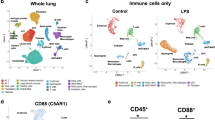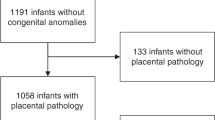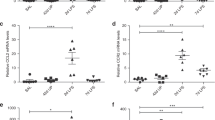Abstract
Background:
Chorioamnionitis, an inflammatory gestational disorder, commonly precedes preterm delivery. Preterm infants may be at particular risk for inflammation-related morbidity related to infection, although the pathogenic mechanisms are unclear. We hypothesized that maternal inflammation modulates immune programming to drive postnatal inflammatory processes.
Methods:
We used a novel combined murine model to treat late gestation dams with low-dose lipopolysaccharide (LPS) and to secondarily challenge exposed neonates or weanlings with Sendai virus (SeV) lung infection. Multiple organs were analyzed to characterize age-specific postnatal immune and inflammatory responses.
Results:
Maternal LPS treatment enhanced innate immune populations in the lungs, livers, and/or spleens of exposed neonates or weanlings. Secondary lung SeV infection variably affected neutrophil, macrophage, and dendritic cell proportions in multiple organs of exposed pups. Neonatal lung infection induced brain interleukin (IL)-4 expression, although this response was muted in LPS-exposed pups. Adaptive immune cells, including lung, lymph node, and thymic lymphocytes and lung CD4 cells expressing FoxP3, interferon (IFN)-γ, or IL-17, were variably prominent in LPS-exposed pups.
Conclusion:
Maternal inflammation modifies postnatal immunity and augments systemic inflammatory responses to viral lung infection in an age-specific manner. We speculate that inflammatory modulation of the developing immune system contributes to chronic morbidity and mortality in preterm infants.
Similar content being viewed by others
Log in or create a free account to read this content
Gain free access to this article, as well as selected content from this journal and more on nature.com
or
References
Lahra MM, Jeffery HE . A fetal response to chorioamnionitis is associated with early survival after preterm birth. Am J Obstet Gynecol 2004;190:147–51.
Jobe AH . Effects of chorioamnionitis on the fetal lung. Clin Perinatol 2012;39:441–57.
Velten M, Heyob KM, Rogers LK, Welty SE . Deficits in lung alveolarization and function after systemic maternal inflammation and neonatal hyperoxia exposure. J Appl Physiol (1985) 2010;108:1347–56.
Velten M, Britt RD Jr, Heyob KM, et al. Prenatal inflammation exacerbates hyperoxia-induced functional and structural changes in adult mice. Am J Physiol Regul Integr Comp Physiol 2012;303:R279–90.
Adkins B, Leclerc C, Marshall-Clarke S . Neonatal adaptive immunity comes of age. Nat Rev Immunol 2004;4:553–64.
Levy O . Innate immunity of the newborn: basic mechanisms and clinical correlates. Nat Rev Immunol 2007;7:379–90.
Zhao J, Kim KD, Yang X, Auh S, Fu YX, Tang H . Hyper innate responses in neonates lead to increased morbidity and mortality after infection. Proc Natl Acad Sci USA 2008;105:7528–33.
Rogers LK, Velten M . Maternal inflammation, growth retardation, and preterm birth: insights into adult cardiovascular disease. Life Sci 2011;89:417–21.
Sorokin Y, Romero R, Mele L, et al. Maternal serum interleukin-6, C-reactive protein, and matrix metalloproteinase-9 concentrations as risk factors for preterm birth <32 weeks and adverse neonatal outcomes. Am J Perinatol 2010;27:631–40.
Bhattacharya S, Beal BT, Janowski AM, Shornick LP . Reduced inflammation and altered innate response in neonates during paramyxoviral infection. Virol J 2011;8:549.
Grayson MH, Ramos MS, Rohlfing MM, et al. Controls for lung dendritic cell maturation and migration during respiratory viral infection. J Immunol 2007;179:1438–48.
Elovitz MA, Brown AG, Breen K, Anton L, Maubert M, Burd I . Intrauterine inflammation, insufficient to induce parturition, still evokes fetal and neonatal brain injury. Int J Dev Neurosci 2011;29:663–71.
Gouyon JB, Rozé JC, Guillermet-Fromentin C, et al. Hospitalizations for respiratory syncytial virus bronchiolitis in preterm infants at <33 weeks gestation without bronchopulmonary dysplasia: the CASTOR study. Epidemiol Infect 2013;141:816–26.
Juntti H, Osterlund P, Kokkonen J, et al. Cytokine responses in cord blood predict the severity of later respiratory syncytial virus infection. J Allergy Clin Immunol 2009;124:52–58.e1–2.
Tiegs G, Lohse AW . Immune tolerance: what is unique about the liver. J Autoimmun 2010;34:1–6.
Egelston C, Kurkó J, Besenyei T, et al. Suppression of dendritic cell maturation and T cell proliferation by synovial fluid myeloid cells from mice with autoimmune arthritis. Arthritis Rheum 2012;64:3179–88.
Kawashima H, Kashiwagi Y, Ioi H, et al. Production of chemokines in respiratory syncytial virus infection with central nervous system manifestations. J Infect Chemother 2012;18:827–31.
Kallapur SG, Kramer BW, Knox CL, et al. Chronic fetal exposure to Ureaplasma parvum suppresses innate immune responses in sheep. J Immunol 2011;187:2688–95.
Azizia M, Lloyd J, Allen M, Klein N, Peebles D . Immune status in very preterm neonates. Pediatrics 2012;129:e967–74.
Mukherjee S, Allen RM, Lukacs NW, Kunkel SL, Carson WF 4th . STAT3-mediated IL-17 production by postseptic T cells exacerbates viral immunopathology of the lung. Shock 2012;38:515–23.
Krishnamoorthy N, Khare A, Oriss TB, et al. Early infection with respiratory syncytial virus impairs regulatory T cell function and increases susceptibility to allergic asthma. Nat Med 2012;18:1525–30.
Wang G, Miyahara Y, Guo Z, Khattar M, Stepkowski SM, Chen W . “Default” generation of neonatal regulatory T cells. J Immunol 2010;185:71–8.
Black A, Bhaumik S, Kirkman RL, Weaver CT, Randolph DA . Developmental regulation of Th17-cell capacity in human neonates. Eur J Immunol 2012;42:311–9.
Ye J, Su X, Hsueh EC, et al. Human tumor-infiltrating Th17 cells have the capacity to differentiate into IFN-γ+ and FOXP3+ T cells with potent suppressive function. Eur J Immunol 2011;41:936–51.
Thornburg NJ, Shepherd B, Crowe JE Jr . Transforming growth factor beta is a major regulator of human neonatal immune responses following respiratory syncytial virus infection. J Virol 2010;84:12895–902.
Pelletier M, Maggi L, Micheletti A, et al. Evidence for a cross-talk between human neutrophils and Th17 cells. Blood 2010;115:335–43.
Salas AA, Faye-Petersen OM, Sims B, et al. Histological characteristics of the fetal inflammatory response associated with neurodevelopmental impairment and death in extremely preterm infants. J Pediatr 2013;163:652–7.e1–2.
Welliver RC Sr, Checchia PA, Bauman JH, Fernandes AW, Mahadevia PJ, Hall CB . Fatality rates in published reports of RSV hospitalizations among high-risk and otherwise healthy children. Curr Med Res Opin 2010;26:2175–81.
Seok J, Warren HS, Cuenca AG, et al.; Inflammation and Host Response to Injury, Large Scale Collaborative Research Program. Genomic responses in mouse models poorly mimic human inflammatory diseases. Proc Natl Acad Sci USA 2013;110:3507–12.
Jackson GL, Engle WD, Sendelbach DM, et al. Are complete blood cell counts useful in the evaluation of asymptomatic neonates exposed to suspected chorioamnionitis? Pediatrics 2004;113:1173–80.
Gantert M, Been JV, Gavilanes AW, Garnier Y, Zimmermann LJ, Kramer BW . Chorioamnionitis: a multiorgan disease of the fetus? J Perinatol 2010;30:S21–30.
Leviton A, Dammann O, Engelke S, et al.; ELGAN study investigators. The clustering of disorders in infants born before the 28th week of gestation. Acta Paediatr 2010;99:1795–800.
Wennekamp J, Henneke P . Induction and termination of inflammatory signaling in group B streptococcal sepsis. Immunol Rev 2008;225:114–27.
Nguyen TL, Khurana SS, Bellone CJ, et al. Autoimmune gastritis mediated by CD4+ T cells promotes the development of gastric cancer. Cancer Res 2013;73:2117–26.
Favrais G, Schwendimann L, Gressens P, Lelièvre V . Cyclooxygenase-2 mediates the sensitizing effects of systemic IL-1-beta on excitotoxic brain lesions in newborn mice. Neurobiol Dis 2007;25:496–505.
Untergasser A, Cutcutache I, Koressaar T, et al. Primer3–new capabilities and interfaces. Nucleic Acids Res 2012;40:e115.
Koressaar T, Remm M . Enhancements and modifications of primer design program Primer3. Bioinformatics 2007;23:1289–91.
Acknowledgements
We acknowledge Richard DiPaolo and Thanh-Long Nguyen for sharing their knowledge of murine flow cytometry and thank Somashubra Bhattacharya for expert technical assistance. We appreciate Noah Hillman’s critical review of our manuscript. This work was presented in part at the 2012 (Boston, MA) and 2013 (Washington, DC) annual Pediatric Academic Societies meetings.
Author information
Authors and Affiliations
Corresponding author
Supplementary information
Supplementary Figure S1
(TIFF 285 kb)
Supplementary Figure S2
(TIFF 253 kb)
Supplementary Table S1
(DOC 33 kb)
Supplementary Table S2
(DOC 26 kb)
Rights and permissions
About this article
Cite this article
Gleditsch, D., Shornick, L., Van Steenwinckel, J. et al. Maternal inflammation modulates infant immune response patterns to viral lung challenge in a murine model. Pediatr Res 76, 33–40 (2014). https://doi.org/10.1038/pr.2014.57
Received:
Accepted:
Published:
Issue date:
DOI: https://doi.org/10.1038/pr.2014.57
This article is cited by
-
ILC2 regulates hyperoxia-induced lung injury via an enhanced Th17 cell response in the BPD mouse model
BMC Pulmonary Medicine (2023)
-
Pulmonary immune cell transcriptome changes in double-hit model of BPD induced by chorioamnionitis and postnatal hyperoxia
Pediatric Research (2021)
-
A perfect storm: fetal inflammation and the developing immune system
Pediatric Research (2020)
-
Preterm birth and sustained inflammation: consequences for the neonate
Seminars in Immunopathology (2020)
-
Neonatal neutrophils stimulated by group B Streptococcus induce a proinflammatory T-helper cell bias
Pediatric Research (2018)



